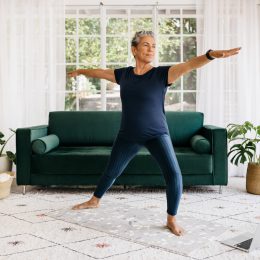Find Your Place: The Eye Health Screen
This quick test checks your peripheral vision. Bonus: It’s also a fun brain game!
Can you locate all 26 letters of the alphabet in order from a jumble of letters on the wall? In this video, SilverSneakers fitness expert David Jack explains how this quick test gives you clues about your peripheral vision. It’s also a fun brain game that challenges your memory.
Watch the video and try the test now, then see what your results mean below. If you have glaucoma or a condition that affects your peripheral vision, you can skip the test, but check out the tips below.
How to Set Up the Test
You have two options for the test. You can choose which one works for you based on the materials, space, and time you have.
Option 1, shown in video: You’ll need a surface about 2 feet by 2 feet to draw on, such as a poster board or dry erase board. If you have balance issues or injuries, or would feel more comfortable seated, you’ll also need a sturdy chair.
After drawing your dot in the center and the letters around it, stand or sit so that the center dot is about 2 feet away and at eye level. Check:
- Can you read all the letters clearly? If you have to squint, move closer to the center dot.
- Are the outer letters in your peripheral vision so that you can only see them from the corner of your eye? If not, step back.
Option 2, not shown in video: A quick hack is to draw your dot and letters on a regular piece of paper that’s about 8.5 inches by 11 inches. Hold it so that the center dot is at arm’s length and eye level. If you have to squint, bring the paper closer to you.
Now you’re ready. Keeping your eyes on the center dot, can you spot all the letters in order?
If Were Able to See All the Letters Clearly
That’s a sign you have good peripheral vision. But to truly protect your peepers, you’ll want to schedule regular eye exams as needed, depending on your age and health.
Adults 60 and older: A yearly comprehensive dilated eye exam is recommended, according to the National Institute on Aging. It’s tempting to skip this if you haven’t noticed any vision problems, but many eye diseases don’t have early symptoms that the average person would spot. Check out six age-related vision problems and what to do about them.
Adults with diabetes: You’ll want to get a comprehensive dilated eye exam at least once a year. Diabetes and high blood sugar increase your risk of eye problems and blindness. Regular vision checkups—along with good blood sugar control—help preserve your sight.
Check with your health plan for benefits information, or check Medicare coverage here.
If You Experienced Tunnel Vision
Was it harder to see the outer letters? This tunnel vision, or loss of peripheral vision, is a red flag for glaucoma—and it’s a sign to call your eye doctor.
Subscribe to our newsletter
It's quick and easy. You could be one of the 13 million people who are eligible.
Already a member? Click to discover our 15,000+ participating locations.
Follow Us
“Glaucoma is called the ‘sneak thief’ in that vision is gradually lost, permanently,” says Alan D. Mendelsohn, M.D., an ophthalmologist in Miami. It’s caused by increased pressure within the eyeball. Typically, there are no early symptoms, so you may not realize that damage is occurring.
To help get the proper diagnosis and treatment, tell your eye doctor about any:
- Chronic conditions you have
- Medications and supplements you take
- Symptoms you’ve experienced
If You Have Glaucoma or a Condition That Affects Your Peripheral Vision
Afraid to exercise with glaucoma? A healthy lifestyle—including exercise—can help you manage your eye and overall health. If you have other conditions, like diabetes or high blood pressure, it’s even more important that you stay active.
The key is working with your doctor, or doctors if you are being treated by multiple people, to find the right plan for you. Ask these three questions:
- What types of exercise are appropriate for me?
- How often and how much should I do them?
- Are there precautions or steps I should take?
Once you know how you can exercise safely, look for fun ways to get moving. Need inspiration? Browse through the workout programs on the SilverSneakers GO app (free, iOS and Android).
Check Your SilverSneakers Eligibility Instantly
SilverSneakers gives you free, unlimited access to more than 15,000 gyms and fitness centers across the nation, plus classes and tools designed to keep older adults strong and independent. Check your eligibility instantly here. Already a member? Get your SilverSneakers member ID and exclusive content by logging in to or creating your online account here.





